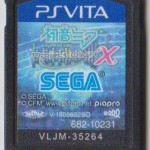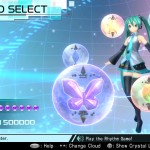Hatsune Miku: Project Diva X (PS Vita Review)
This title was reviewed after playing a Japanese copy of the title and therefore some terms may not line up with the European and North American versions of the game.
So here we are with Hatsune Miku: Project Diva X; the tenth title in the Project Diva series. That’s quite an impressive innings considering the franchise begun in 2009, but when you think about it, the core structure of these games has stayed pretty rigid since its inception so it must be pretty easy to tweak from game to game. Each title basically introduces you to a fresh playlist of songs to choose from and some additional mechanics that sometimes work well and sometimes don’t. So where does Project Diva X stand?
Well to begin with, Project Diva X is probably the slightest when it comes to songs. This title has only 30 songs to its name in the core package and it’s quite noticeable once you’ve gone through the game’s main mode Live Quest as you’re often tasked to play the same songs again under different conditions in the Event Quests section. What’s a little different this time around is a few songs are often compiled into medleys which become a real test of your abilities as the tempos can vary wildly in a single song and while it would be nice to play the songs that appear in the medleys in full, this offers a nice change to the traditional gameplay that is actually very welcome.
Speaking of new additions, the entire structure of Project Diva X has been changed dramatically. Everything is accessible from the Live Quest menu which is now melded seamlessly with the Diva Room. This means that any items you unlock through completing songs makes them instantly appear in the room you see from the main Live Quest menu. It’s a really sweet touch to have your spoils displayed front and centre every time you finish a song and it makes the presence of the Diva Room actually feel like a vital part of the game.
Songs are also displayed in a different way. Songs are now grouped into 5 “elements”; Classic, Cool, Cute, Elegant and Quirky. These elements are supposed to represent the style of music available in each of the songs that appear here and it makes your progression through the game feel a little more involved than simply selecting the next song from a huge playlist.
Completing a song now gives you “voltage” which is displayed as a score. Once your voltage reaches a certain number, you then clear the element and can move onto the next. A certain amount of voltage is needed to clear each song and you can actually increase the amount of voltage you can score by assigning a module (i.e. costume) and accessories that match the element. It’s a nice little touch that means you often experiment with more modules instead of just assigning the recommended module for the song and sticking with that.
Finally, there are some tweaks to the actual gameplay itself. Scratch notes (notes that needed to be swiped on the touch screen to score) have been stripped back to their raw elements. You no longer have the double scratch notes from Project Diva F or the link scratch notes from Project Diva F 2nd. This is quite a welcome change as the scratch notes have never sat right with me as the feedback never feels particularly satisfying when you score them. I’d still rather they weren’t there at all, but this is an acceptable compromise. The new note to Project Diva X takes the form of the Rush Note; a note where you have to rapidly press the corresponding button to score it. The rush notes remind me of the outro segments in Rock Band titles where you’re allowed to freestyle and they’re quite satisfying to score.
Additionally, chance time (a challenging segment of the song that can wield bonuses if cleared well) has also been altered slightly. Due to the removal of any in game currency to unlock items from a store, chance time now has a more functional purpose in that clearing it will allow you to unlock modules. These can vary from random modules that can be unlocked in any song to rare modules that can only be obtained by meeting certain criteria in certain songs. It’s also entirely possible to unlock a module you already own. It’s a nice touch that feels great when you nail it, even if the resulting sound effects can be a little distracting as you continue with the final part of the song.
The main negative with Project Diva X is just how noticeably repetitive it is compared to other titles. Once the elements are cleared, the only additional missions come in the form of the Event Quests where the rules of entry and more rigidly defined. These missions require you to equip different Vocaloids or choose 3 songs from a limited list of tracks that must be played as “special live” events where you have to clear all 3 songs in a row. It adds a little bit of variety to the game but because you’re playing the same songs over and over, it never really feels like it’s doing enough to really make these missions feel special. This is also exacerbated by the more limited playlist.
Hatsune Miku: Project Diva X definitely marks a point in the series where it’s probably refined its core elements so well that it feels like there’s nowhere left for the series to go. There’s now so many different types of notes, extra missions and additional stuff to do in the Diva Room that when you compare it to a title like Hatsune Miku: Project Diva Future Tone, it feels like the developers have over-egged the pudding somewhat. Future Tone is such a focussed and stripped back title that it feels bizarrely refreshing compared to Project Diva X. Future Tone puts its music front and centre and always keeps the focus on playing the songs, while Project Diva X can sometimes feel like it’s bombarding you with new concepts for the sake of it.
There’s no denying this is still another great entry in the series and it’s probably one of the most approachable and well-structured games of the lot, but it still raises a lot of questions as to where this series can go going forward because Project Diva X’s focus is on refinement and not on new ideas.
8/10
Written by Lewis “Sonic Yoda” Clark on 25/01/2017















